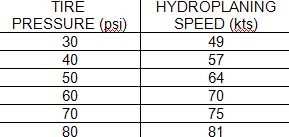Sun, Jul 02, 2006
Aero-Tips!
A good pilot is always learning -- how many times have you
heard this old standard throughout your flying career? There is no
truer statement in all of flying (well, with the possible exception
of "there are no old, bold pilots.")

Aero-News has called upon the expertise of Thomas P. Turner,
master CFI and all-around-good-guy, to bring our readers -- and us
-- daily tips to improve our skills as aviators. Some of them, you
may have heard before... but for each of us, there will also be
something we might never have considered before, or something that
didn't "stick" the way it should have the first time we memorized
it for the practical test.
Look for our daily Aero-Tips segments, coming each day to
you through the Aero-News Network.
Aero-Tips 07.02.06
Landing on a wet runway? Beware of hydroplaning.
Hydroplaning occurs when a thin film of water builds between a
tire and actually lifts it from the runway. Tires are no longer in
contact with the ground; braking looses its effectiveness, and you
may not be able to steer the airplane.
Studies show that hydroplaning can occur in as little as
one-tenth inch of water. The speed at which an airplane tire
hydroplanes is a direction function of the tire pressure. The National Aeronautics and Space Administration
(NASA) identifies the hydroplaning critical speed as
nine times the square root of the tire pressure. This means most
light airplanes can hydroplane at as low as 50 knots.

NASA Critical Speed for
Hydroplaning
Landing on a wet runway
Aviation legend Sparky Imeson tells us that to avoid
hydroplaning when landing on a wet runway:
- Touch down as close to the approach end of the runway as
possible, to maximize available landing distance
- Plan a firm arrival, to put the tires solidly against the
pavement
- Lower the nose wheel as soon as possible to maximize steering
capability
- Avoid applying brakes at or above the NASA critical speed for
your airplane
- Retract flaps to put more weight on the wheels, increasing
directional control (note: attempting to retract flaps during the
landing roll is a common cause of inadvertent landing gear
retraction in retractable-gear airplanes)
- Divert to a more suitable airport if a wet runway is combined
with a crosswind
Aero-tip of the day: Anticipate hydroplaning,
and adjust your landing technique accordingly.
More News
The Industry Continues to be Rocked By Some Questionable Operations Recent investigations and a great deal of data has resulted in ANN’s SportPlane Resource Guide’s rep>[...]
Make Sure You NEVER Miss A New Story From Aero-News Network Do you ever feel like you never see posts from a certain person or page on Facebook or Instagram? Here’s how you c>[...]
Visual Approach Slope Indicator (VASI) An airport lighting facility providing vertical visual approach slope guidance to aircraft during approach to landing by radiating a directio>[...]
Airport Marking Aids Markings used on runway and taxiway surfaces to identify a specific runway, a runway threshold, a centerline, a hold line, etc. A runway should be marked in ac>[...]
Aero Linx: The Skyhawk Association The Skyhawk Association is a non-profit organization founded by former Skyhawk Pilots which is open to anyone with an affinity for the A-4 Skyhaw>[...]
 Unfortunate... ANN/SportPlane Resource Guide Adds To Cautionary Advisories
Unfortunate... ANN/SportPlane Resource Guide Adds To Cautionary Advisories ANN FAQ: Turn On Post Notifications
ANN FAQ: Turn On Post Notifications ANN's Daily Aero-Term (04.29.24): Visual Approach Slope Indicator (VASI)
ANN's Daily Aero-Term (04.29.24): Visual Approach Slope Indicator (VASI) ANN's Daily Aero-Term (04.28.24): Airport Marking Aids
ANN's Daily Aero-Term (04.28.24): Airport Marking Aids ANN's Daily Aero-Linx (04.28.24)
ANN's Daily Aero-Linx (04.28.24)




